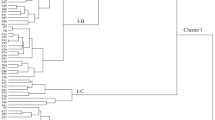Abstract
Several different methods using different numbers of plants and observations have been used for characterisation of germplasm. In this study, two different observation strategies for characterisation were tested in order to determine the minimum number of observations and plants per accession whilst still obtaining accurate results using eight forage legume species, eight forage grass species multiplied from seeds and eight clonally propagated forage grass species. In most cases, 10 observations, with 1 observation per plant would be sufficient to reach an acceptable error percentage. Observations taken on a plant basis with one observation per plant appears to be the most efficient way of scoring morphological characters. If less than 10 plants per accession are available, the reduced number of plants can be compensated by taking more observations per plant. An acceptable error percentage can often not be reached when the number of plants is less than four or five, even if many observations per plant are taken.
Similar content being viewed by others
References
Bishop, H.G., B.C. Pengelly & D.H. Ludke, 1988. Classification and description of a collection of the legume genus Aeschynomene. Tropical Grasslands 22: 160–175.
Box, G.E.P, W.G. Hunter & J.S. Hunter, 1978. Statistics for experimenters. An Introduction to Design, Data Analysis, and Model Building. John Wiley & Sons, N.Y.
Cochran, W.G., 1963. Sampling techniques. John Wiley & Sons, N.Y.
Dalenius, I. & J.L. Hodges Jr., 1959. Minimum variance stratification. Jour. Amer. Stat. Assoc. 54: 88–101.
Edye, L.A., R.L. Burt, C.H.L. Nicholson, R.J. Williams & W.T. Williams, 1974. Classification of the Stylosanthes collection, 1928–69. CSIRO Aust. Div. Trop. Agron. Tech. Pap. 15: 1–28.
Francisco-Ortega, J., B.R. Reghunath, H.J. Newbury & B.V. Ford-Lloyd, 1993. Discrimination between groups of tagasaste and escobon from the Canary Islands based on juvenile morphological characters. New Zealand Journal of Agricultural Research 36: 185–195.
Fu, S.M., J.G. Hampton & W.M. Williams, 1994. Description and evaluation of serradella (Ornithopus L.) accessions. New Zealand Journal of Agricultural Research 37: 471–479.
Hakiza, J.J., J.R. Lazier & A.R. Sayers, 1988. Characterisation and preliminary evaluation of accessions of Zornia species from the ILCA collection. In: Pasture Network for Eastern and Southern Africa (PANESA) African forage plant genetic resources, evaluation of forage germplasm and extensive livestock production systems. Proceedings of the Third Workshop held at the International Conference Centre, Arusha, Tanzania, 27–30 April 1987, ILCA, Addis Ababa. pp. 149–173.
Heering, J.H., S. Nokoe & J. Mohammed, 1996. The classification of a Sesbania sesban (ssp. sesban) collection. 1. Morphological attributes and their taxonomic significance. Tropical Grasslands 30: 206–214.
IBPGR, 1991. Descriptors for Annual Medicago/ Descripteurs pour Medicago annuelles. International Board for Plant Genetic Resources, Rome, Italy.
IBPGR, 1992. Descriptors for white clover (Trifolium repens L.). International Board for Plant Genetic Resources, Rome, Italy.
Pengelly, B.C., J.B. Hacker & D.A. Eagles, 1992. The classification of a collection of buffel grasses and related species. Tropical Grasslands 26: 1–6.
Pengelly, B.C. & D.A. Eagles, 1995. Geographical distribution and diversity in a collection of the tropical legume Macroptilium gracile (Poeppiga ex Bentham) Urban. Australian Journal of Agricultural Research 46: 569–580.
Purseglove, J.W. 1982. Tropical Crops Dicotyledons. Longman, Essex, U.K.
Rohlf, F.J. & M.C. Wooten, 1988. Evaluation of the restricted maximum-likelihood method for estimation phylogenetic trees using simulated allele-frequency data. Evolution 42: 581–595.
Skerman, P.J., D.G. Cameron & F. Riveros, 1988. Tropical forage legumes. Food and Agriculture Organization of the United Nations, Rome, Italy.
Skerman, P.J. & F. Riveros, 1990. Tropical grasses. Food and Agriculture Organization of the United Nations, Rome, Italy.
Smith, F.P., P.S. Cocks & M.A. Ewing, 1995a. Variation in the morphology and flowering time of cluster clover (Trifolium glomeratum L.) and its relationship to distribution in Southern Australia. Australian Journal of Agricultural Research 46: 1027–1038.
Smith, S.E., L. Guarino, A. Al-Doss & D.M. Conta, 1995b. Morphological and agronomic affinities among Middle Eastern Alfalfas-Accessions from Oman and Yemen. Crop Science 35: 1188–1194.
Tcacenco, F.A. & G.N. Lance, 1992. Selection of morphological traits for characterisation of elephant grass accessions. Tropical Grasslands 26: 145–155.
Yadav, M.S., K.L. Mehra & M.L. Magoon, 1974. Genetic variability and correlations of a few quantitative characters in the pasture grass, Cenchrus ciliaris. Indian Forester 512–517.
Author information
Authors and Affiliations
Rights and permissions
About this article
Cite this article
van de Wouw, M., Hanson, J. & Nokoe, S. Observation strategies for morphological characterisation of forages. Genetic Resources and Crop Evolution 46, 63–71 (1999). https://doi.org/10.1023/A:1008627527822
Issue Date:
DOI: https://doi.org/10.1023/A:1008627527822




